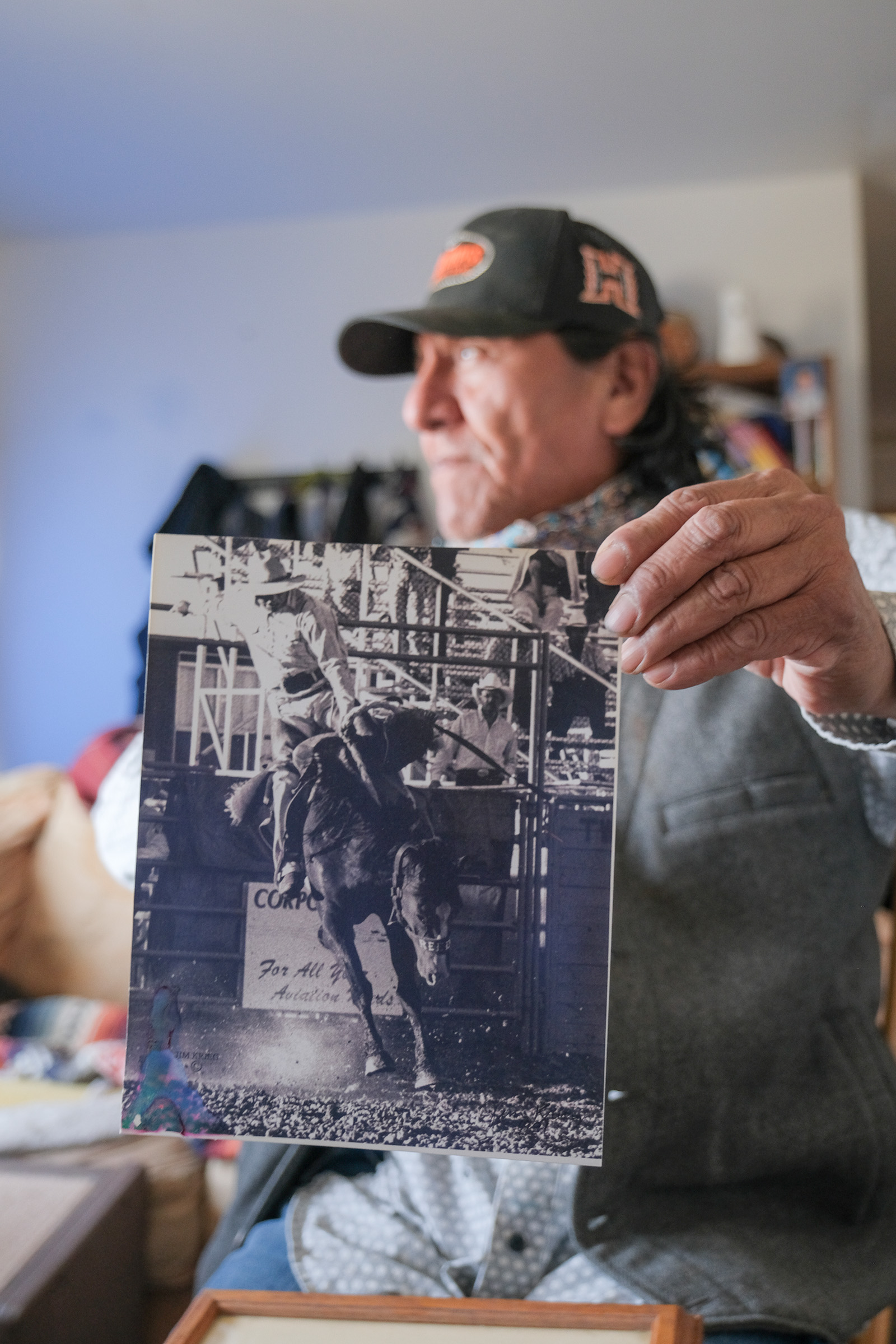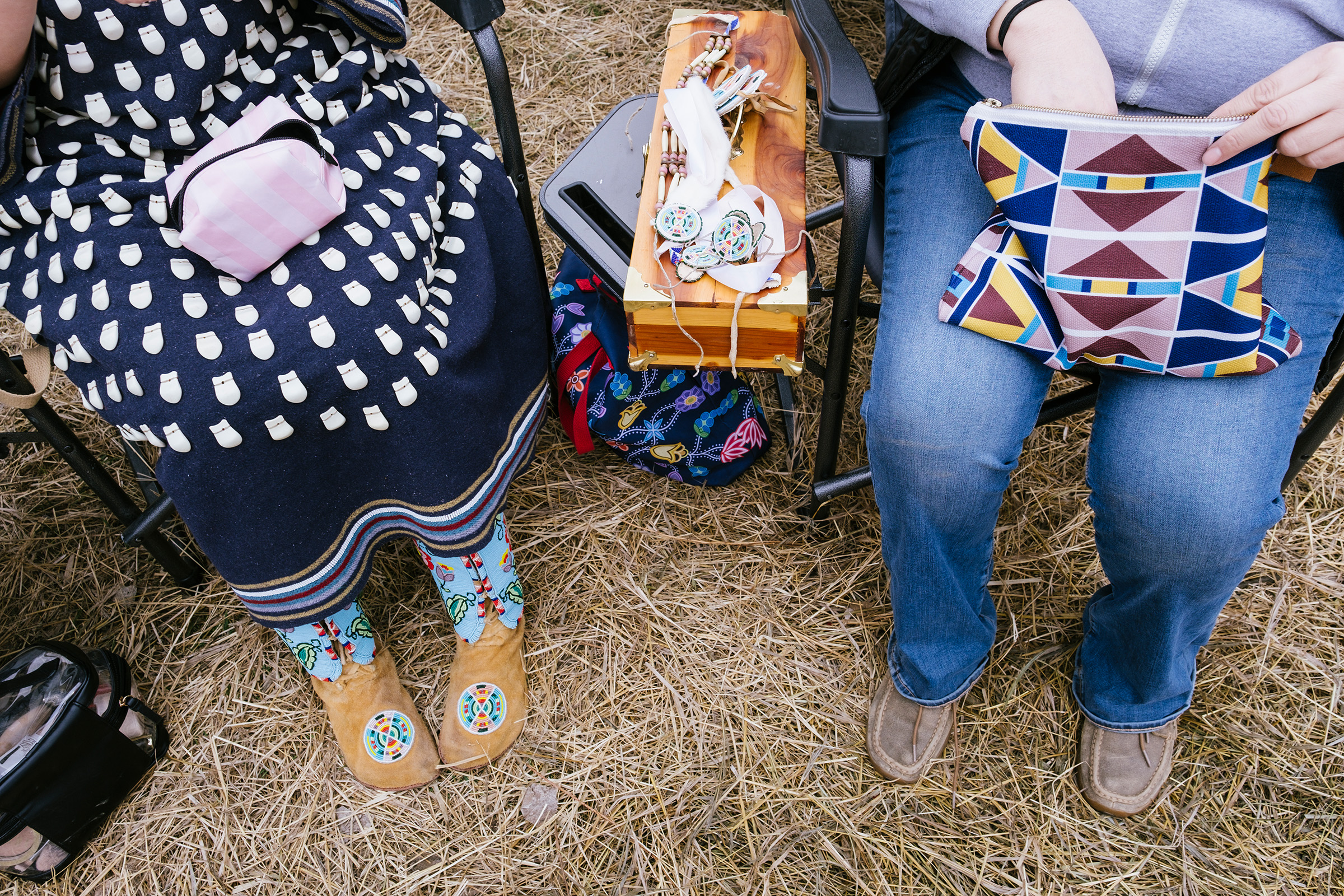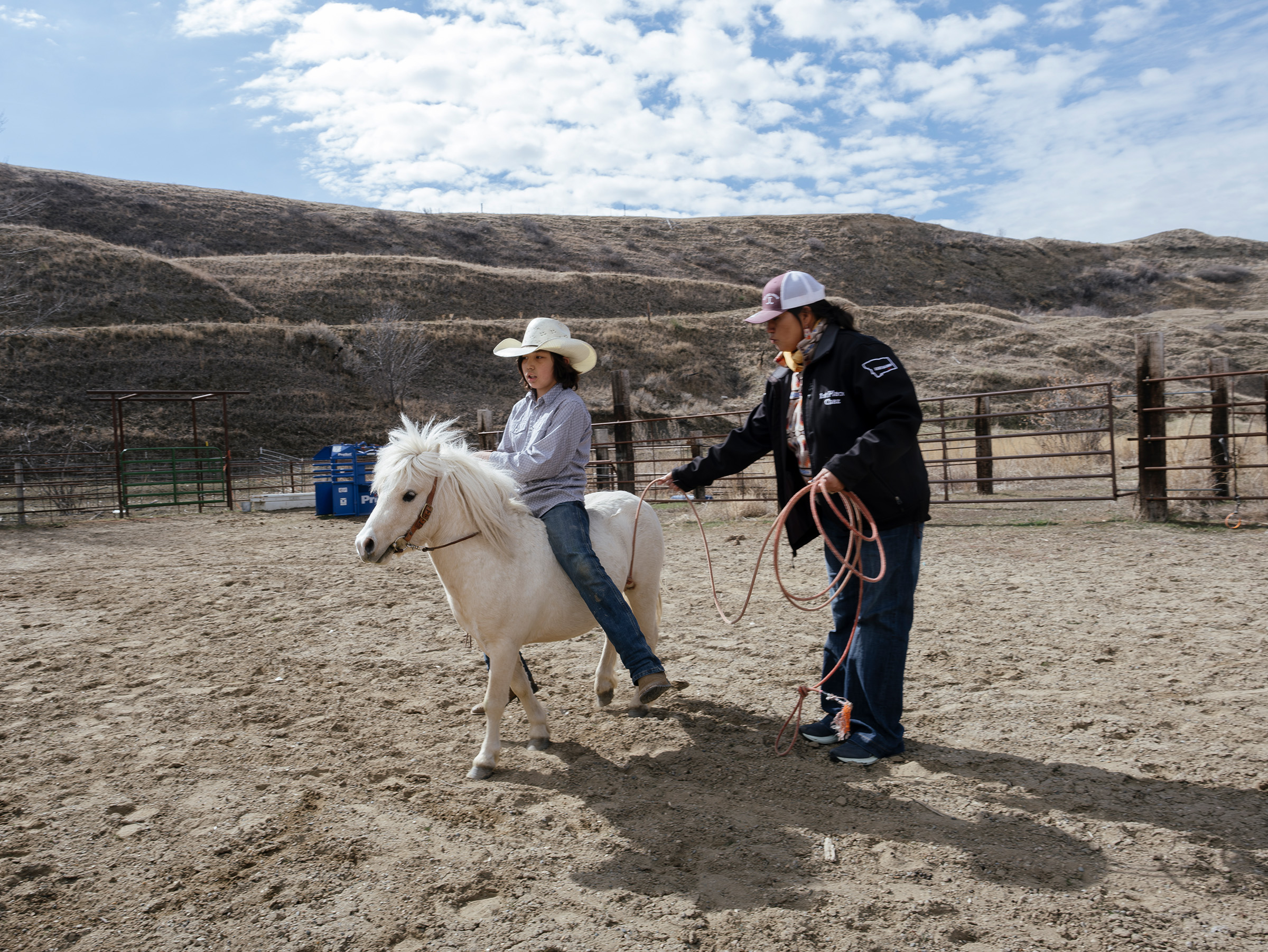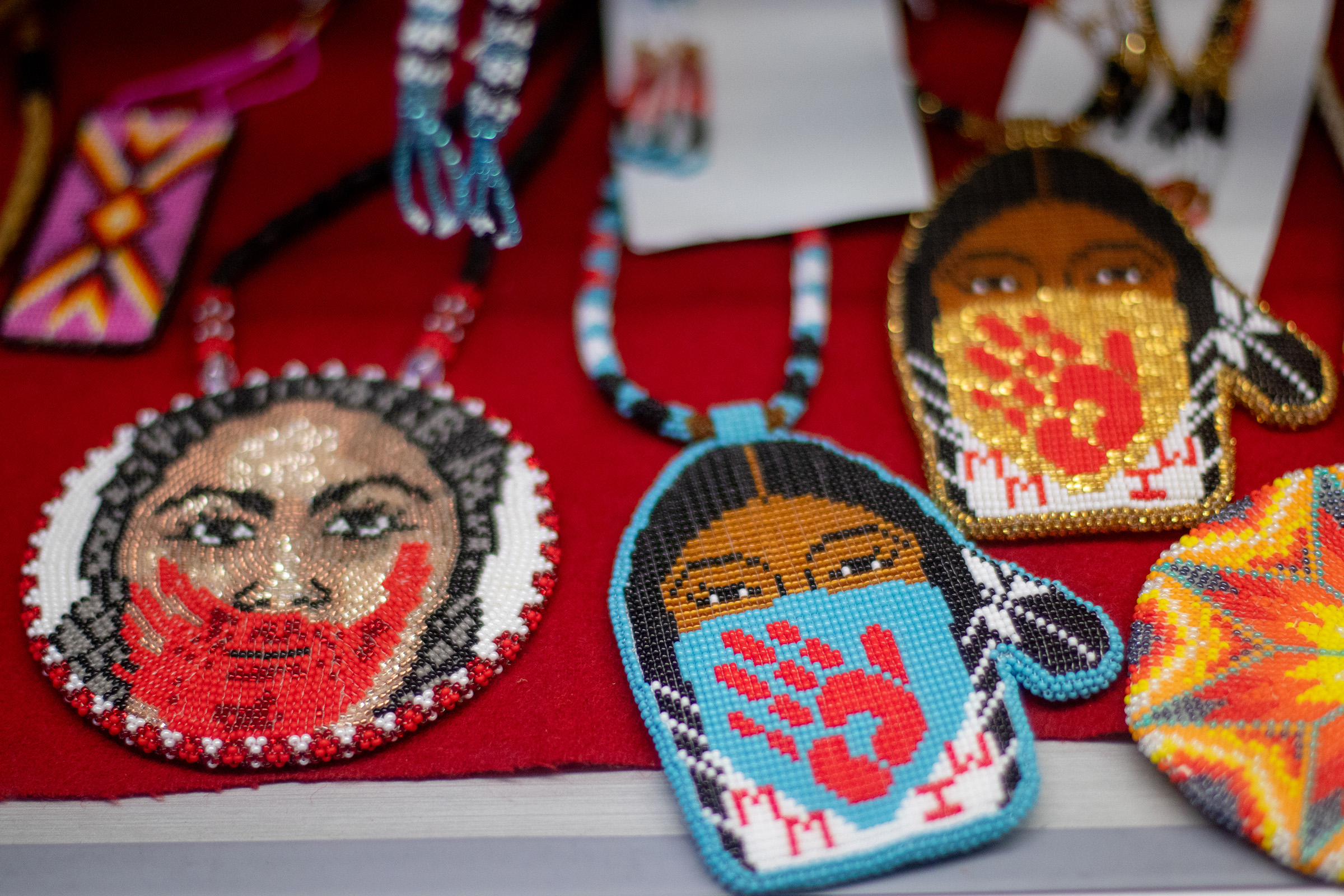By the Reins
Apsáalooke’s kinship with the horse cultivates connection
Story by Liz Dempsey. Photos by Maddie McCuddy.
Shawn Real Bird spends up to three hours a day tending to his horses, providing constant access to food and water and personally attending to their needs. He owns about 25 of them, and considers caring for them a sacred duty.
If the river is frozen, he will cut through the ice to expose water. He monitors their diet carefully, recognizing the impact of green grass on their behavior and adjusting their nutrition accordingly. For instance, tall green grass can give the horse a “high,” which raises the probability of the younger horses bucking, Real Bird said.
Enlarge

He is constantly touching or interacting with horses, regularly grooming and warming them when needed. Then there’s all the necessary veterinary care to keep them healthy and sound.
Enlarge

“Once you put your time into a horse, ride it and make it a good horse, it becomes a family member,” Real Bird said. “You know its personality, what it likes or doesn’t, how hyper it is or how fast it is.”
This work is an obligation, Real Bird said. As a citizen of the Crow Nation, he comes from a lineage deeply rooted in the art of horsemanship. The Crow Nation has a deep hi story that reveres the horse in daily life, in art and in religion. For horse owners like Real Bird, his relationship with the animal was ingrained in him like it was in his father and the generations before him.
Real Bird’s first language is Crow, so he will talk to or identify his horses in his language. They all have English names, but he was trained to know them by their color, age and purpose. He often, in Crow, calls them xáxxe (Paint horse), xáxxe baaiá (young Paint), xáxxe xaaliá (old Paint).
“They don’t make themselves tame,” Real Bird said. He breeds racehorses, the ones “born to run.” If he doesn’t tend to his horses, the wild in them becomes strong. Same with other breeds of horses, like the ones “born to perform,” which also need tending to and training. Real Bird and his brother, Tim, specialize in training horses.
In the fast-paced world of the 21st century, the unique relationship between the Crow people and horses persists, serving as a vital connection to their culture and identity.
Tim McCleary, department head at Little Bighorn College, said the first horses integrated into the Crow Tribe came as captures from the Shoshone Tribe. The arrival of horses marked a significant shift in Crow culture, symbolized by geographic warrior art depicting horses on buffalo robes and teepees.
“Horses quickly became integral to Crow consciousness, with the Crow considering them one of the three living beings with a soul, alongside humans and dogs,” McCleary said. While specifics of what happens after death may vary, the concept of a soul implies continuity beyond physical life, suggesting a form of existence beyond the earthly realm.
Enlarge

Historical government policies, such as restrictions on horse ownership in the 1920s, severely impacted the Crow’s relationship with horses, leading to a significant decline in the horse population on the reservation.
Known as the Horse Kills of the 1920s, the Crow people were limited to owning only two horses under government policies. The surplus of horses was either surrendered to the agency for shipment or, in some cases, killed.
Enlarge

As a result, in just three years, the horse population was severely reduced at the hands of federal policy. However, this changed in 1936 with the passage of the Indian Recognition Act that terminated assimilation policies like the Dawes Act and advocated for the preservation of Indigenous practices. According to a 2003 study published in the “Journal of American Indian Higher Education,” such policies resulted in the elimination of more than 44,000 horses that had belonged to the Crow.
Enlarge

The loss of horses inflicted trauma upon the community, as revealed through Chief Plenty Coups’ letters shedding light on instances where government employees allegedly killed horses, underscoring the diminishing authority of tribal chiefs during that era.
Indigenous peoples have stories about horses long before European contact, including evidence of horse bone tools and hunting practices from that era. According to a 2023 study, “Early Dispersal of Domestic Horses into the Great Plains and Northern Rockies,” horses were in North America in the 16th century and as far back as up to 6,000 years ago.
“The history of horses in America is under debate,” said William Taylor, assistant professor and curator of archaeology at the University of Colorado Museum of Natural History. This suggests “that horses were integrated into Indigenous cultures in the American Great Plains and Rocky Mountains decades before European records indicate.”
The study directly challenges the European narrative that horses arrived after the Pueblo Revolt in 1680 and provides archaeological evidence indicating Indigenous integration of horses prior to this event.
“This study highlights the need for collaborative research to tell more inclusive stories,” said Taylor, one of its 80-plus authors. The study’s findings reveal that regions such as Idaho, Wyoming, Kansas and down into New Mexico had already begun deeply integrating domestic horses into Indigenous society by at least the turn of the 17th century or early 1600s.
In this study, collaboration with the Lakota, Comanche and Pawnee Nations validated traditional perspectives on the timing and manner of horse integration into Indigenous cultures. These tribes played a crucial role in providing traditional narratives and a more inclusive understanding of the history of horses in North America.
Enlarge

Enlarge

—
Jade Bends’ property immediately paints an image of a country home of solace and fulfillment. Their house sits at the heart of the action, surrounded by a barn, a horse corral and rolling hills.
In the distance, Jade’s son, Timber Bends, tears around on a four-wheeler, helping his dad, Chaz Bends, with the morning horse feed.
Jade Bends, a citizen of Crow Nation and affiliated with Navajo, reflects on how horses are ingrained in her very being.
“We grew up with them. It’s just who we are,” she said. For Jade Bends and her family, horses aren’t just animals; they play a role in the family. The horses teach her kids responsibility and keep them grounded in their culture.
But Jade Bends noticed a troubling trend among the youth on the reservation. In Lodge Grass, kids used to ride horses all the time. Now, it’s not as common. She believes it’s because many families are struggling, dealing with poverty, addiction and broken homes. “It’s a ripple effect from our history,” she said. “Things like forced relocation and land theft have made it harder for families to have horses.”
Despite the challenges, Jade Bends is determined to make a difference. She organizes youth rodeo programs, offering kids a chance to connect with their culture through horses. It is therapeutic and keeps them out of trouble, she said.
For her, the horse symbolizes resilience. “They’ve been around our tribes for a hundred years,” she said. In an area like the Crow Indian Reservation, where some have lost touch with their roots, Jade Bends is determined to keep the culture alive, using horses as a bridge to their identity. Horses have such a strong tie to many Crow citizens. It’s not hard to find stories about their integration as family members.
Enlarge

—
At a young age, Noel Two-Leggins, a citizen of the Crow Nation, was with his grandfather when he was breaking a horse. His grandfather instructed him to mount the horse.
Two-Leggins was hesitant, but he had no choice. His grandfather secured him to the horse’s neck with a rope, marking the beginning of their bond. Two-Leggins was thrown off and had to persist, prompted by his grandfather to remount. This continued until the horse relented.
This method was not the end of the traditional horse-breaking process. Two-Leggins’ grandfather then took him to the river with the horse. He directed Two-Leggins to ride against the current repeatedly until the horse acquiesced once more. This traditional way underscored the bond between man and beast, transforming the once-wild horse into Two-Leggins’ trusted companion.
It became Two-Leggins’ responsibility to care for the horse. Reflecting on the experience, Two-Leggins likened it to scenes from the movie “Avatar,” finding parallels in the struggle to establish a connection with an animal.
While this method of horse-breaking is now uncommon, modern techniques prevail. The Crow people consider their horses as family, believing that any misfortune befalling the horse is an omen of similar fate for the human family members.
“The creator, or whatever higher power exists, knew that death was imminent for that family,” Two-Leggins said. “Instead of taking a human life, the life of the horse or dog is taken as a substitute.”
Enlarge

—
Henry Reed Sr., a former jockey, smiled as he picked up a bag of food for his horses. “A lot of people know me, but I don’t know a lot of people,” he said. Reed had two colts he was preparing to train, hoping they will become rideable for his grandchildren. “I call that one Painted Lady,” he said.
Growing up, Reed was practically raised on horseback due to his father’s racehorses. His first taste of racing came at the age of 8 at the Crow Fair, igniting a lifelong passion for the sport. Working on a ranch from an early age, Reed honed his skills as a cowboy, particularly enjoying roping. He and his father would break and train horses together, eventually leading Reed to pursue a career as a jockey.
Reflecting on the significance of horses in Crow culture, Reed emphasized their sacredness. “The horse is very sacred for the Crows; that is how we survived,” he said. In cultural tradition, killing a horse is taboo, believed to bring repercussions from the Maker. If a horse became injured, the Crow would seek assistance from outsiders to kill it.
—
Enlarge

Similar to Bends, Velma Pickett’s life revolves around horses, but in the context of Indian Relay rather than rodeo. Her husband, Cody Pickett, has been a part of the River Road Relay team for nine years, and their entire family has been immersed in the world of horses since childhood. The team practices diligently, galloping their horses daily and conducting weekly practice runs. As summer approaches, they participate in races almost every weekend.
During practice rounds, Kingston Hugs, a junior at Hardin High School, showcased his agility by riding each horse three times around the track, simulating the crucial exchange process of Indian Relay. Pickett emphasizes the importance of smooth exchanges, which require skill and talent. The relay not only keeps the team busy, but also instills a sense of purpose and pride, particularly among the young men who find honor and glory in their achievements.
For Pickett and her family, Indian Relay is more than just a sport; it’s a way of preserving cultural traditions and strengthening their identity as Native Americans. She knows that horse racing has been ingrained in the culture for generations and that Indian Relay allows them to carry on this legacy while fostering a sense of pride in their heritage.
Reflecting on the broader impact of equine therapy, Pickett acknowledged its role in keeping the community’s youth engaged and away from negative influences. By participating in Indian Relay, they channel their energy into something positive, preventing them from succumbing to the temptations of addiction.
—
Enlarge

The Crow Fair, identified as the “teepee capital of the world,” serves as a vibrant showcase of Crow culture, particularly in its grand parade held every August. Here, horses and their riders adorn themselves in elaborate beaded regalia, a testament to the enduring tradition of equine artistry and craftsmanship.
The day begins early for participants, rising at 6 a.m. to prepare for the parade that commences at 10 a.m. They groom and feed their horses before attending to the horses’ regalia. The beadwork, painstakingly crafted, covers the horses with mesmerizing designs, some of which are valued at very high prices, reflecting the skill and dedication of the beadwork.
Enlarge

Amber Cummins, mother of Cailei Cummins, reflected on the laborious process of beadwork, where even the slightest prick of a needle is a reminder of the dedication poured into each piece. As she unveiled her horse’s regalia, including items like a cradle board, the depth of craftsmanship and cultural significance became apparent.
“I probably have my blood under all these beads,” she said.
A SPECIAL PROJECT BY THE UNIVERSITY OF MONTANA SCHOOL OF JOURNALISM
ADDITIONAL FUNDING SUPPORT FROM THE GREATER MONTANA FOUNDATION
READ MORE:
Previous
Breach of Trust
Next
Indian Ed for Some

